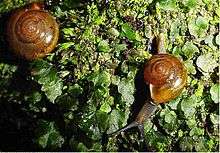Macrochlamys indica
| Macrochlamys indica | |
|---|---|
 | |
| Two live individuals of Macrochlamys indica | |
| Scientific classification | |
| Kingdom: | Animalia |
| Phylum: | Mollusca |
| Class: | Gastropoda |
| (unranked): | clade Heterobranchia
clade Euthyneura |
| Superfamily: | Helicarionoidea |
| Family: | Ariophantidae |
| Subfamily: | Macrochlamydinae |
| Genus: | Macrochlamys |
| Species: | M. indica |
| Binomial name | |
| Macrochlamys indica Benson, 1832 | |
Macrochlamys indica is a species of air-breathing land snail, a terrestrial pulmonate gastropod mollusk in the family Ariophantidae.
Distribution
This species occurs in countries including:
This species has not yet become established in the USA, but it is considered to represent a potentially serious threat as a pest, an invasive species which could negatively affect agriculture, natural ecosystems, human health or commerce. Therefore, it has been suggested that this species be given top national quarantine significance in the USA.[3]
Shell description
The shell is perforate, depressed, smooth, polished throughout, translucent, pale brownish tawny, not distinctly striated, but with microscopic longitudinal impressed lines, slightly flexuous and not close together. The spire is low, conoid. The suture is slightly impressed. The shell has 5.5 whorls, that are slightly convex above. The last whorl is not descending. The last whorl is rounded at the periphery and moderately convex beneath.[1]
The aperture is slightly oblique and broadly lunate. The peristome is thin in one plane, with columellar margin is curved, oblique, never quite vertical, carried forward and briefly reflected above.[1]
The width of the shell is 16-18.5 mm. The height of the shell is 8.5 mm.[1]
Anatomy

The animal is purplish grey not black, elongate. The right shell-lobe is small, the left is narrowly reflected over the edge of the peristome, and at the basal side gives off a short tongue-like process. The right dorsal lobe is narrow and elongate, the left in two distinct portions.[1]
In the genitalia is a moderately long cylindrical blunt kalc-sac is given off at the junction of the vas deferens, and the caecum of the penis, to which the retractor muscle is attached, is sharply coiled. The dart-sac is long, the spermatheca short and elongately pearshaped.[1]
The radula contains about 88 rows of teeth, with the arrangement: 34.2.9.1.9.2.34 (45.1.45).[1]
References
The article incorporates public domain text from the reference.[1]
- 1 2 3 4 5 6 7 8 Blanford W. T. & Godwin-Austen H. H. 1908. The Fauna of British India, Including Ceylon and Burma. Mollusca. Testacellidae and Zonitidae. Taylor & Francis, London, page 95-96.
- ↑ Commonwealth of Australia. 2002 (April) Citrus Imports from the Arab Republic of Egypt. A Review Under Existing Import Conditions for Citrus from Israel. Agriculture, Fisheries and Forestry, Australia. Caption: Gastropods, page 12 and Appendix 2.
- ↑ Cowie R. H., Dillon R. T., Robinson D. G. & Smith J. W. (2009). "Alien non-marine snails and slugs of priority quarantine importance in the United States: A preliminary risk assessment". American Malacological Bulletin 27: 113-132. PDF.
Further reading
- El-Alfy N. Z., Al-Ali K. A. & Abdel-Rahim A. H. 1994. Karotype, meiosis and sperm formation in the land snail Macrochlamys indica. Qatar University Science Journal 14(1), 122–128.
| Wikimedia Commons has media related to Macrochlamys indica. |